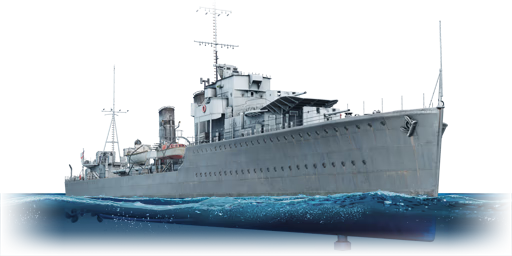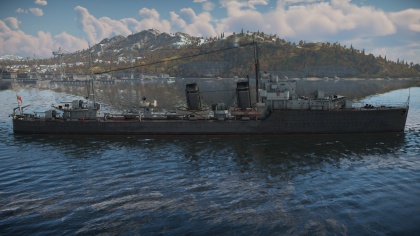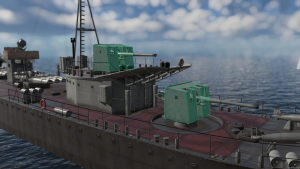Difference between revisions of "HMS Grafton"
(Edits) |
(Tag: Visual edit) |
||
| Line 7: | Line 7: | ||
The '''{{Specs|name}}''' is a rank {{Specs|rank}} British destroyer {{Battle-rating}}. It was introduced in [[Update 1.83 "Masters of the Sea"]] as part of the British fleet closed beta test. | The '''{{Specs|name}}''' is a rank {{Specs|rank}} British destroyer {{Battle-rating}}. It was introduced in [[Update 1.83 "Masters of the Sea"]] as part of the British fleet closed beta test. | ||
| − | HMS ''Grafton'', pennant number H89, part of the G class, is a destroyer built for the Royal Navy during the 1930s. She had a relatively short | + | HMS ''Grafton'', pennant number H89, part of the G class, is a destroyer built for the Royal Navy during the 1930s. She had a relatively short, diverse and honourable operational history. |
It serves as a combat destroyer introduction to British captains. ''Grafton'' gives the chance to sense the game style of a combat-worthy destroyer. Unlike the [[Town (L45)|Town class]] which are escort destroyers, ''Grafton'' can stand its ground against similar or even superior enemies; thus providing a useful experience for the yet more powerful destroyers down the research tree. | It serves as a combat destroyer introduction to British captains. ''Grafton'' gives the chance to sense the game style of a combat-worthy destroyer. Unlike the [[Town (L45)|Town class]] which are escort destroyers, ''Grafton'' can stand its ground against similar or even superior enemies; thus providing a useful experience for the yet more powerful destroyers down the research tree. | ||
| Line 15: | Line 15: | ||
=== Survivability and armour === | === Survivability and armour === | ||
| − | <!-- ''Talk about the vehicle's armour. Note the most well-defended and most vulnerable zones, e.g. the ammo magazine. Evaluate the composition of components and assemblies responsible for movement and manoeuvrability. Evaluate the survivability of the primary and secondary armaments separately. Don't forget to mention the size of the crew, which plays an important role in fleet mechanics. Save tips on preserving survivability for the "Usage in battles" section. If necessary, use a graphical template to show the most well-protected or most vulnerable points in the armour.'' --> | + | <!-- ''Talk about the vehicle's armour. Note the most well-defended and most vulnerable zones, e.g. the ammo magazine. Evaluate the composition of components and assemblies responsible for movement and manoeuvrability. Evaluate the survivability of the primary and secondary armaments separately. Don't forget to mention the size of the crew, which plays an important role in fleet mechanics. Save tips on preserving survivability for the "Usage in battles" section. If necessary, use a graphical template to show the most well-protected or most vulnerable points in the armour.'' -->[[File:G-class Main armour .png|thumb|'''4.97 mm''' of antifragmentation armour on Grafton's main gun.]] |
The crew size is an essential indicator of survivability amongst destroyers. HMS ''Grafton'' does not offer any significative advantage over other Rank I destroyers, with her crew being only of 145. Captains must be prudent in their combat actions to preserve the life of their complement. | The crew size is an essential indicator of survivability amongst destroyers. HMS ''Grafton'' does not offer any significative advantage over other Rank I destroyers, with her crew being only of 145. Captains must be prudent in their combat actions to preserve the life of their complement. | ||
| Line 22: | Line 22: | ||
* '''12.7 mm''' of antifragmentation armour | * '''12.7 mm''' of antifragmentation armour | ||
* '''4.97 mm''' of antifragmentation armour | * '''4.97 mm''' of antifragmentation armour | ||
| + | |||
| + | This antifragmentation armour stops HE shells and low calibre machine guns '''(7.7mm)'''. But it won't be enough to stop heavy machine gun calibre or higher, also any SAP shell or HE with base fuze will disable the turret. Thus the only use of the armour is to conceal and to fragment any HE shells; protecting the crew and the gun's breech from the shrapnel while the armour resists the damage. | ||
| + | |||
| + | The HMS Grafton's hull is made of '''16 mm''' of steel while the superstructure is protected by '''10 mm''' steel. | ||
| + | |||
| + | This armour won't provide significant protection against most of the destroyer's main calibre shells (120 mm +). The hull armour is only practical against 12.7 mm or less. | ||
| + | |||
| + | The superstructure can protect against low calibre machine guns but any aircraft with automatic cannons like the Soviet [[IL-2 (1941)|Il-2]] or the German [[Ju 87 (Family)|Junkers]] will easily pierce the superstructure of the ship. Hence increasing the risk of an ammo rack detonation because of the aircraft's strafing rounds. This packed with the poor anti-air defences is not a good deed for survivability. Be observant! | ||
=== Mobility === | === Mobility === | ||
| Line 34: | Line 42: | ||
''Provide information about the characteristics of the primary armament. Evaluate their efficacy in battle based on their reload speed, ballistics and the capacity of their shells. Add a link to the main article about the weapon: <code><nowiki>{{main|Weapon name (calibre)}}</nowiki></code>. Broadly describe the ammunition available for the primary armament, and provide recommendations on how to use it and which ammunition to choose.'' | ''Provide information about the characteristics of the primary armament. Evaluate their efficacy in battle based on their reload speed, ballistics and the capacity of their shells. Add a link to the main article about the weapon: <code><nowiki>{{main|Weapon name (calibre)}}</nowiki></code>. Broadly describe the ammunition available for the primary armament, and provide recommendations on how to use it and which ammunition to choose.'' | ||
| − | === | + | === Anti-aircraft armament === |
{{main|Vickers Mk.V (12.7 mm)}} | {{main|Vickers Mk.V (12.7 mm)}} | ||
| Line 94: | Line 102: | ||
=== Pros and cons === | === Pros and cons === | ||
| − | + | <!-- Summarise and briefly evaluate the vehicle in terms of its characteristics and combat effectiveness. Mark its pros and cons in the bulleted list. Try not to use more than 6 points for each of the characteristics. Avoid using categorical definitions such as "bad", "good" and the like - use substitutions with softer forms such as "inadequate" and "effective". --> | |
'''Pros:''' | '''Pros:''' | ||
| + | |||
| + | * Powerful main armaments of 4x 120 mm guns, with a great explosive mass of 3 kg | ||
| + | * Useful mobility and adequate turning time | ||
| + | * 8x Torpedoes are useful for area saturation | ||
| + | * Diversity of shells for the main guns (HE, SAP, HE-TF, HE-VT) | ||
| + | * Main guns can perform as anti-air guns | ||
| + | * Improved speed and armament when compared with reserve [[Town (L45)|HMS Churchill]] | ||
| + | |||
* | * | ||
'''Cons:''' | '''Cons:''' | ||
| − | * | + | |
| + | * Below average crew size; captains could not realize how fast it decreases | ||
| + | * Absence of auxiliary armament of any sort | ||
| + | * Only 2x 12.7 mm anti-air machine guns; also deficient due to short-range (-2000m) | ||
| + | * Poor protection of the ammo ready and main racks; they can be easily detonated | ||
| + | * Reduced numbers of depth charges guns; no guns in the stern of the ship | ||
== History == | == History == | ||
| Line 123: | Line 144: | ||
== See also == | == See also == | ||
''Links to articles on the War Thunder Wiki that you think will be useful for the reader, for example:'' | ''Links to articles on the War Thunder Wiki that you think will be useful for the reader, for example:'' | ||
| + | |||
* ''reference to the series of the ship;'' | * ''reference to the series of the ship;'' | ||
* ''links to approximate analogues of other nations and research trees.'' | * ''links to approximate analogues of other nations and research trees.'' | ||
Revision as of 03:58, 16 December 2020
Contents
Description
The G-class, HMS Grafton (H89), 1936 is a rank British destroyer
with a battle rating of (AB), (RB), and (SB). It was introduced in Update 1.83 "Masters of the Sea" as part of the British fleet closed beta test.
HMS Grafton, pennant number H89, part of the G class, is a destroyer built for the Royal Navy during the 1930s. She had a relatively short, diverse and honourable operational history.
It serves as a combat destroyer introduction to British captains. Grafton gives the chance to sense the game style of a combat-worthy destroyer. Unlike the Town class which are escort destroyers, Grafton can stand its ground against similar or even superior enemies; thus providing a useful experience for the yet more powerful destroyers down the research tree.
General info
HMS Grafton performs excellently in the destroyer vs destroyer area, thanks to her 4 x 4.7 inch/45 Mk.XII (120 mm) main guns. Her mobility is also remarkable, but the less appealing aspects are her lacklustre anti-air defences and the yet below-average crew size.
Survivability and armour
The crew size is an essential indicator of survivability amongst destroyers. HMS Grafton does not offer any significative advantage over other Rank I destroyers, with her crew being only of 145. Captains must be prudent in their combat actions to preserve the life of their complement.
The armour present on the HMS is limited to gun shielding and turret protections consisting of:
- 12.7 mm of antifragmentation armour
- 4.97 mm of antifragmentation armour
This antifragmentation armour stops HE shells and low calibre machine guns (7.7mm). But it won't be enough to stop heavy machine gun calibre or higher, also any SAP shell or HE with base fuze will disable the turret. Thus the only use of the armour is to conceal and to fragment any HE shells; protecting the crew and the gun's breech from the shrapnel while the armour resists the damage.
The HMS Grafton's hull is made of 16 mm of steel while the superstructure is protected by 10 mm steel.
This armour won't provide significant protection against most of the destroyer's main calibre shells (120 mm +). The hull armour is only practical against 12.7 mm or less.
The superstructure can protect against low calibre machine guns but any aircraft with automatic cannons like the Soviet Il-2 or the German Junkers will easily pierce the superstructure of the ship. Hence increasing the risk of an ammo rack detonation because of the aircraft's strafing rounds. This packed with the poor anti-air defences is not a good deed for survivability. Be observant!
Mobility
Write about the ship's mobility. Evaluate its power and manoeuvrability, rudder rerouting speed, stopping speed at full tilt, with its maximum forward and reverse speed.
| Mobility Characteristics | |||
|---|---|---|---|
| Game Mode | Upgrade Status | Maximum Speed (km/h) | |
| Forward | Reverse | ||
| AB | |||
| Upgraded | |||
| RB/SB | |||
| Upgraded | |||
Armament
Primary armament
Provide information about the characteristics of the primary armament. Evaluate their efficacy in battle based on their reload speed, ballistics and the capacity of their shells. Add a link to the main article about the weapon: {{main|Weapon name (calibre)}}. Broadly describe the ammunition available for the primary armament, and provide recommendations on how to use it and which ammunition to choose.
Anti-aircraft armament
Some ships are fitted with weapons of various calibres. Secondary armaments are defined as weapons chosen with the control Select secondary weapon. Evaluate the secondary armaments and give advice on how to use them. Describe the ammunition available for the secondary armament. Provide recommendations on how to use them and which ammunition to choose. Remember that any anti-air armament, even heavy calibre weapons, belong in the next section. If there is no secondary armament, remove this section.
Torpedo armament
Torpedo launchers are standard equipment on many ships and boats. Torpedoes are a significant means of defeating an opponent. Evaluate the position of the torpedo launchers, discuss the ammunition available, firing specifics such as dead zones, features of the torpedoes themselves, etc. If there is no torpedo armament, remove this section.
Special armament
Depth charges, mines, rocket launchers and missiles are also effective in skilled hands and can take an off-guard opponent by surprise. Evaluate the ammunition of this type of armament and rate its performance in combat. If there are no special armaments, remove this section.
Usage in battles
Describe the technique of using this ship, the characteristics of her use in a team and tips on strategy. Abstain from writing an entire guide – don't try to provide a single point of view, but give the reader food for thought. Talk about the most dangerous opponents for this vehicle and provide recommendations on fighting them. If necessary, note the specifics of playing with this vehicle in various modes (AB, RB, SB).
Modules
| Tier | Seakeeping | Unsinkability | Firepower | |||
|---|---|---|---|---|---|---|
| I | Dry-Docking | Tool Set | 4.7 inch SAP Mk.VA | 12.7 mm I | ||
| II | Rudder Replacement | Fire Protection System | Smokescreen | 4.7 inch HE-TF Mk.VIIA | 12.7 mm API | Auxiliary Armament Targeting |
| III | Propeller Replacement | Ventilation | Shrapnel Protection | Improved Rangefinder | Primary Armament Targeting | |
| IV | Engine Maintenance | New Pumps | Ammo Wetting | 4.7 inch HE-VT Mk.VIIA | Bomb mortar | Torpedo Mode |
Pros and cons
Pros:
- Powerful main armaments of 4x 120 mm guns, with a great explosive mass of 3 kg
- Useful mobility and adequate turning time
- 8x Torpedoes are useful for area saturation
- Diversity of shells for the main guns (HE, SAP, HE-TF, HE-VT)
- Main guns can perform as anti-air guns
- Improved speed and armament when compared with reserve HMS Churchill
Cons:
- Below average crew size; captains could not realize how fast it decreases
- Absence of auxiliary armament of any sort
- Only 2x 12.7 mm anti-air machine guns; also deficient due to short-range (-2000m)
- Poor protection of the ammo ready and main racks; they can be easily detonated
- Reduced numbers of depth charges guns; no guns in the stern of the ship
History
HMS Grafton was laid down in August 1934 as the fifth ship of nine G-class destroyers being built by British dockyards in the interwar years. Almost two years later, in March 1936, the ship was completed and joined the ranks of the Royal Navy.
HMS Grafton spent her early service days as part of the 1st Destroyer Flotilla operating in the Mediterranean. During the Spanish Civil War, HMS Grafton assisted in enforcing the non-intervention policy alongside warships of other nations.
During the outbreak of WW2 in September 1939, HMS Grafton was undergoing refits at Malta, being called back to British waters in the following October. In early 1940, Grafton underwent minor overhaul work before being assigned to escort convoys headed for Norway.
At the same time, the war situation in France was looking desperate with the start of the Siege of Calais. Operation Dynamo, the allied effort of evacuating cut-off troops from Dunkirk, commenced shortly after. HMS Grafton answered the call and assisted with evacuating troops from the 27th, May 1940.
Two days later however, HMS Grafton spotted survivors of the previously sunk destroyer HMS Wakeful and stopped to commence rescue efforts. Stationary, Grafton presented herself as easy prey for any attacker. Soon enough, she found herself in the crosshairs of the German submarine U-62.
Although severely damaged by the torpedo attack, HMS Grafton stayed afloat long enough for her survivors to be rescued by the destroyer HMS Ivanhoe. Realizing the extent of her damage, the decision was made to scuttle HMS Grafton by gunfire from Ivanhoe. After the shelling, HMS Grafton quickly sank to the bottom, marking the end of her service life and contribution to WW2.
- From Devblog
Media
Excellent additions to the article would be video guides, screenshots from the game, and photos.
See also
Links to articles on the War Thunder Wiki that you think will be useful for the reader, for example:
- reference to the series of the ship;
- links to approximate analogues of other nations and research trees.
External links
| Britain destroyers | |
|---|---|
| Town-class | HMS Churchill · HMS Montgomery |
| V-class | HMS Valhalla · HMS Vega · HMS Verdun |
| G-class | HMS Grafton · ORP Garland |
| Hunt-class | HMS Calpe · HMS Brissenden |
| Tribal-class | HMCS Haida · HMS Eskimo · HMS Mohawk |
| J-class | HMS Jervis |
| K-class | HMS Kelvin |
| N-class | HMAS Nepal |
| Battle-class | HMS Armada · HMS Cadiz · HMAS Tobruk |
| Daring-class | HMS Daring · HMS Diamond · HMS Diana |






